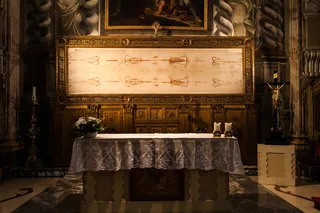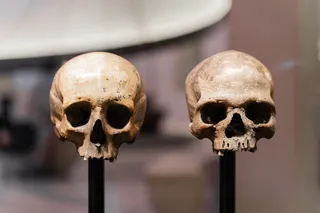A new fresco discovered at Pompeii further muddies the already murky history of pizza and the age-old art of putting toppings on flatbread. Found in an atrium buried under a collapsed ceiling and layers of pumice and volcanic ash, the painting shows a round bun loaded with toppings and condiments next to a massive vessel of wine.
Does this 2,000-year-old food item count as an early pizza?
A statement from the Archaeological Park of Pompeii, which oversees the site, says that “Whilst it looks like a pizza … [it] obviously can't be, since some of the most characteristic ingredients are missing, namely tomatoes and mozzarella.”
But the park’s director, archaeologist Gabriel Zuchtriegel, doesn’t dismiss the idea outright. He draws a parallel between the refined painting of simple foods and pizza’s rise from street food to great cultural significance.
“How can we not think about pizza,” he says in a statement, “also born as a ‘poor’ dish in southern Italy that has now conquered the world and is served in Michelin star restaurants.”
Read More: The Discovery of 7,200-Year-Old Cheese and Other Ancient Food and Drink
Who Invented Pizza?
The tomato-based food as we know it today began in Naples in the 18th and 19th centuries as sustenance for the working poor, who needed quick, high-calorie food. Immigrants took the food to the U.S., where it found new popularity in the 1940s and became a global phenomenon.
But centuries before, the Ancient Greeks likely baked flatbreads and topped them with cheese, garlic, herbs and oil, giving them a claim to early pizza fame. But flatbread was commonplace in many ancient cultures, including the Ancient Egyptians, who made bread using a type of wheat, emmer, that rose little.
The new painting at Pompeii was discovered around the corner from a bakery, along with the skeletons of three people found in surrounding work rooms.
The Way Greeks Treated Guests
At the time of the Vesuvius’ eruption in the year A.D. 79, Pompeii was a Roman city with deep Greek roots, and the painting reflects the Grecian “xenia” tradition of giving elaborate gifts of food to guests. These could include fruits, vegetables, chickens, eggs and other products, according to a paper by Zuchtriegel and archaeologist Alessandro Russo.
The painting contains two shelves, including a lower one and an upper one that holds all the food. It ranges from yellow strawberry tree fruits to loose dates, pomegranates, dried fruit and perhaps a fig. Atop the bread, the painter depicted bright colors that could represent spices or condiments or even pesto.
The silver tray with handles puzzled the researchers as it doesn’t match any of the actual, solid trays found at Pompeii, where serving dishes were more common. The same can be said of the bowl-like wine vessel, although the researchers found a similar one in another of Pompeii’s many still life paintings. Although archaeologists have found about 300 xenia paintings in Vesuvian cities, the latest stands out for its quality of execution.
According to other research, Pompeii residents consumed large quantities of cereal foods, such as grains and, potentially, bread from the city’s many bakeries. The study analyzed chemical isotopes from the victims’ bones and found that men received about a half of their calories from cereals, a figure that was slightly lower for women.
Read More: 5 Ancient Foods Still Eaten Today














